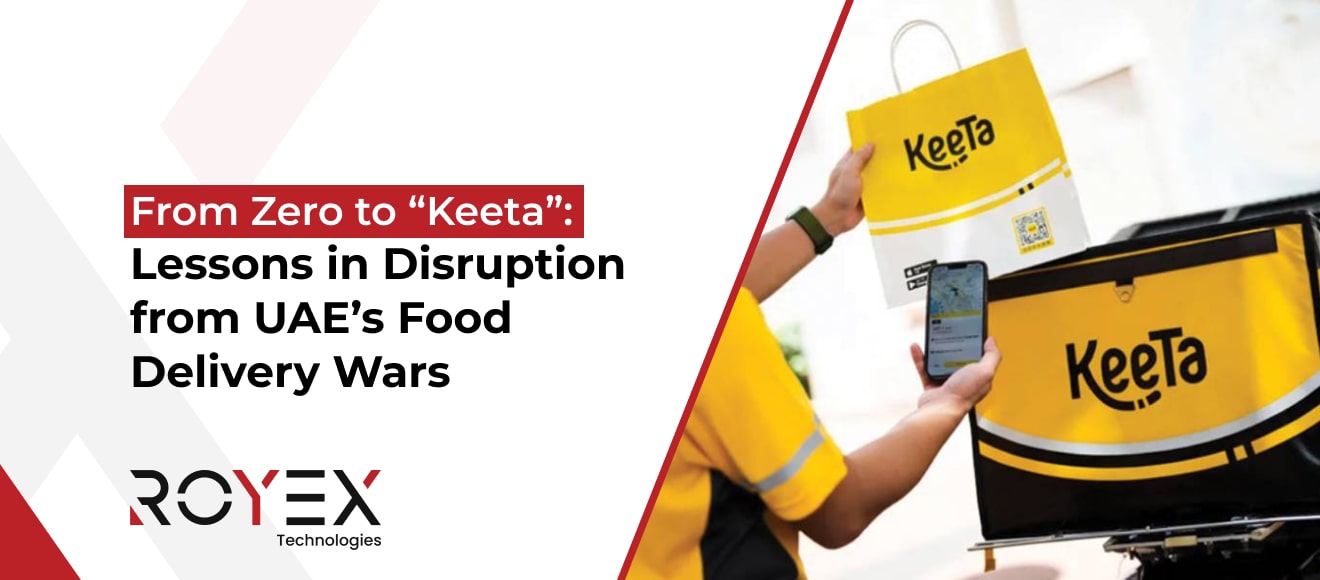
From Zero to “Keeta”: Lessons in Disruption from UAE’s Food Delivery Wars
The UAE’s online food delivery market is booming. In 2024, the market was valued at USD 720.7 million, and analysts expect it to reach USD 1,799.1 million by 2033 (CAGR ~10.2 %). Another estimate suggests growth at ~8.3 % from 2025 to 2030. In GCC more broadly, the market reached USD 3.93 billion in 2023 and is forecast to hit ~USD 11.18 billion by 2030 (CAGR ~14.5 %).
This explosive growth has drawn intense competition. Market incumbents like Talabat, Careem (Now), Uber Eats, Noon Food, and others have entrenched their positions through a mix of retention, subsidy, and ecosystem integration. But into that battlefield steps Keeta, the food-delivery brand launched by Chinese giant Meituan, making a splash in the UAE in late 2025.
For any startup founder, Keeta's entry offers a living case study in how a bold challenger tries to disrupt a saturated, capital-intensive market. This article walks you through:
- How incumbents in UAE run marketing, growth, and retention
- What Keeta is doing differently (or similarly)
- The odds and risks Keeta faces in surviving long term
- Concrete lessons for startup founders (especially in mature/“crowded” markets)
Part I: Marketing & Growth Playbook of UAE Food Delivery Giants
Before judging Keeta’s moves, it helps to understand what the incumbents are doing right (and wrong). Let's examine key players and their strategies.
Talabat: The benchmark
Brand + scale + subscription moat
Omnibus branding & heavy media: Talabat maintains high brand visibility through OOH (billboards, public transport ads), radio, TV, digital, and seasonal blitz campaigns (especially during Ramadan, back-to-school). These campaigns often carry emotional, cultural, safety, or CSR themes (e.g. “hero meals,” road safety).
Talabat Pro (subscription model): For ~AED 19/month, users get free delivery, exclusive discounts, and partner perks. This builds a retention “moat” — switching away becomes costlier.
Partnerships & financial products: Talabat has a co-branded card with ADCB, also bundling wallets, promos, and bank tie-ups, embedding itself deeper in the financial “stack.”
Merchant relationships & onboarding: Talabat invests in merchant education, analytics dashboards, and joint promotions to align incentives. Restaurants depend on Talabat for visibility and volume.
Talabat itself is backing up growth with capital: in late 2024 it launched a Dubai IPO, aiming to raise ~$2 billion. That signals confidence and deep financial backing in defending its turf.
Uber Eats
Global brand, local adaptation: Uber Eats leverages Uber’s existing brand recognition and logistics tech.
Merchant ad platform: It offers restaurants ads/spots on the app (self-serve), boosting their visibility for extra fees. That transforms Uber from mere facilitator to revenue generator.
Cross-product integration: In markets where Uber also offers rides or grocery, it can cross-sell or bundle benefits.
Innovation & PR: Uber often uses tech pilots (autonomous delivery, robotics) for earned media, building a futuristic halo.
Careem (Now a “super-app” approach)
Careem Plus / subscription bundling: Careem offers perks not just in food but rides, grocery, and more. That cross-vertical stickiness reduces user churn.
Reliability & trust play: Guarantees (e.g. credits if late), superior customer support, curated menus for reliability — these are part of the brand promise.
Bank / telco tie-ins: Frequent promos via banks or telecom operators enhance user acquisition and reduce cost per user.
Noon Food & ecosystem bundling
Noon already has e-commerce and groceries. Incorporating food delivery into the existing stack means they can cross-subsidize, route orders through shared logistics, and leverage user base.
The tactic is: use shopping promos, mega-sale days (e.g. Noon 11) to push food orders.
Key shared tactics & insights
Promos & discounts are table stakes
Customer acquisition is heavily subventioned. Every player offers free delivery, Buy-1-Get-1, or “AED 10 off” vouchers regularly.
Subscription / membership as lock-in
Moving from one-time coupons to a recurring subscription reduces reliance on continued discounts.
Guarantee & trust messaging
“On-time guarantee,” “refund if late,” “delivery credits if delay” — these make the promise tangible.
Merchant monetization (ads, priority listing, vouchers)
Let restaurants spend to appear higher or drive incremental orders. This is a more sustainable revenue stream beyond commissions.
Cross-vertical / cross-app bundling
If you already offer rides, groceries, wallets, etc., food becomes another use case in your ecosystem.
Cultural / seasonal hooks
Leverage Ramadan, National Day, FIFA, back-to-school — tie in emotional campaigns and promotions to stay top-of-mind.
PR & “innovation” as marketing
Tech pilots (drone delivery, robotics), expansion news, HQ announcements—all generate media that amplifies the brand beyond ad spend.
Part II: Keeta’s Entry Strategy — Bold, Subsidized, & Aggressive
Keeta is not a small local startup — it's the international arm of Meituan (one of China’s largest local services platforms). Its entry into the UAE illuminates how a well-funded growth machine attacks entrenched markets.
Here’s a close look at what Keeta is doing (or positioning) to grab share.
Rapid regional rollout
Rather than focus on UAE first, Keeta has moved fast across the Gulf:
-
Launched in Qatar (August 2025)
-
Launched in Kuwait (September 2025)
-
Entered UAE (Dubai) by end of September 2025
-
The claim: “third new Middle East market in 40 days”
This blitz launch gives them a “first mover in many sub-markets” vibe, and suggests Meituan is backing this as a strategic international play, not a pilot.
Heavy subsidies & promotional splash
50% off first meals + free delivery + on-time guarantee announced in multiple press releases.
Massive media momentum: app store rankings, PR seeding, press coverage. Keeta reportedly was #1 in UAE App Store “Food & Drink” before even delivering a meal.
Subsidies to attract both users and merchants: “Founding Vendor Program” for early restaurant partners in UAE.
Local anchoring & government alignment
Keeta is setting up a UAE headquarters, promising to create ~350 jobs in the UAE.
They signed an MoU with UAE Ministry of Investment, aligning with national digitalization / AI ambitions.
They are reportedly exploring partnerships with Dubai Taxi Company for logistics synergies, perhaps for “smart / autonomous delivery” experiments.
Infrastructure, scale, and logistics
Meituan brings deep operational playbooks — routing, batching, dispatch optimization, predictive demand.
Potential to use drone / AV / autonomous logistics — this is core to Meituan’s strategy in China and could be part of the differentiation in UAE.
Focus on reliability messaging (“on-time promise”) rather than just discounts — they are positioning quality over just cheap.
Rapid share capture in other markets
In Saudi Arabia, within four months of launch, Keeta became third-largest food delivery platform there.
In China, Meituan has mastered unit economics and scaling operations — Keeta is likely leveraging that institutional muscle.
Part III: Can Keeta Survive & Thrive? The Odds, Risks, and Key Inflection Points
It’s one thing to launch aggressively; surviving in the food delivery business is another challenge entirely. Let’s assess Keeta’s probabilities, key failure modes, and what factors will tip the balance.
Strengths on Keeta’s side
Capital & resources
Meituan is a behemoth with deep war chest, experience, and scale. It’s not starting from zero; Keeta inherits many of Meituan’s systems, engineering talent, and logistics algorithms.
Operational sophistication
Meituan has decades of experience in China’s most competitive cities — how to batch, route, reduce idle time, forecast demand, manage driver pay, etc.
Subsidy tolerance
They can sustain a loss-leading phase longer than local challengers. Many incumbents already operate with tight margins.
Brand and media splash
The “arrival” narrative + PR coverage gives them instant mindshare.
Government alignment & local presence
By embedding in local policy, creating local jobs, and aligning with Dubai’s digitalization goals, they gain legitimacy and potentially favorable regulatory treatment.
Key challenges and risks
Retention / habit formation (post-discount phase)
Once subsidies fade, users will resist high margins unless the product is very sticky. If customers revert to incumbents after promos disappear, the venture will bleed.
Subscription moat & locked incumbents
Talabat Pro, Careem Plus, and other membership programs create entrenched users who may be reluctant to switch unless value is compelling.
High fixed costs & logistics burn
Serving lower-density zones, dealing with failed deliveries, reverse logistics, acquisitions of couriers are all cost centers. If scale or density doesn’t reach a threshold quickly, losses balloon.
Merchant pushback / margin pressure
Restaurants negotiate commissions, promotions, exclusivity. If Keeta asks for too much in terms of commission or marketing money, merchants may resist.
Consumer price sensitivity
UAE users are savvy deal-seekers. They are willing to hop between apps for promos, so loyalty is weak unless you deliver beyond just discounts.
Regulatory, labor, and safety constraints
Food delivery is regulated. Local laws on traffic, licensing, safety, especially drone/AV experiments, could face roadblocks.
Incumbents’ defensive play
Talabat, Careem, Uber Eats will not cede ground quietly—they will raise subsidies, double down on retention, bundle deeper into finance or shopping apps.
What tipping points will decide survival?
-
Retention & frequency before subsidy “valley”: Within 6–12 months, Keeta must prove that a growing base of users will keep ordering even when discount rates decline.
-
Subscription or membership adoption: They need to introduce and scale a “Keeta One / Pro” tier that locks users.
-
Merchant monetization: Ads, priority listings, commission flexibility — converting restaurants into paying partners beyond commissions will help financial viability.
-
Operational efficiency: Optimization in routing, batching, reducing delivery failure rates, minimizing driver idle time will push the unit economics from loss toward break-even.
-
Network effects & density: In dense zones, well-saturated supply and demand ensure efficiency and margin. If Keeta fails to penetrate major zones meaningfully, the burn in lower-tier geographies will kill it.
-
Regulatory & strategic alignment: Maintaining favorable relationships with local government and policies (e.g. delivery licenses, drone regulation) is essential.
Scenario assessment
Best-case: Keeta morphs from a heavy-subsidy entrant into a “third major platform” behind Talabat and Careem. It retains a loyal base, launches a subscription, monetizes merchants, and uses tech to cut costs. In 2–3 years, becomes profitable or self-sustaining in key cities (e.g., Dubai, Abu Dhabi).
Moderate case: Keeta captures ~15–25 % share in cities, but burns cash in lower-density zones; remains subsidy-dependent; possibly ends up as acquisition target or niche regional player.
Worst-case: High churn, inability to reduce subsidies, weak merchant relationships, regulatory hurdles — the venture gradually scales down or retreats to selective zones.
Given Meituan’s backing and aggressive launch, I judge survival is plausible—but success is not guaranteed. The pivotal months are the next 12: will Keeta shift gears from “discount war” to “value & retention war”?
Part IV: Startup Lessons from the Keeta Disruption Playbook
What can founders and growth teams in any sector (not just food delivery) learn from this high-stakes case?
1. Enter with a “line-of-sight” to sustainability, not just growth
Many startups focus on growth at all costs. But without a vision for second- or third-stage monetization (subscriptions, marketplace fees, SaaS tools), growth alone is a trap.
Keeta seems to have built that line-of-sight: subsidies in early days, but underlying levers (merchant ads, membership, logistics efficiency) ready to pull.
2. Use PR, narrative & hype — but back it with execution
Getting “#1 on the app store before launch” or “350 local jobs commitments” generates buzz and can help open doors. But hype without execution collapses fast.
Your product must deliver: reliability, speed, usability. Marketing can get people in the door; product keeps them.
3. Move quickly but not recklessly
Keeta launched in three markets in 40 days — that’s audacity. But each market needs localized adaptation. Scale must be balanced with local relevance.
In your startup, test in a focused geography or segment, learn fast, then scale.
4. Subsidies are weapons, not crutches
Use discounts to punch into the market, not as a long-term strategy. Always ask: “What’s the plan after we remove or reduce this subsidy?”
Your core product and retention must be better than discount-laden.
5. Monetize both sides of the network early
In marketplaces, you often have user side and supplier side. Monetizing only one side (e.g. commissions on restaurants) may not scale. Ads, analytics, premium placement, value-added services are critical.
Uber Eats, Talabat, and likely Keeta do this by letting merchants pay for better positioning or campaign support.
6. Build defensibility beyond discounts
Subscription/membership, ecosystem lock-in (cross-vertical), data & personalization, reliability guarantees — these are harder to replicate than a coupon.
In your startup domain, think of subtle moats: community, integrations, exclusive content, onboarding advantage, etc.
7. Lean into strategic partnerships early
Partnership with banks, telcos, local governments, logistics firms can reduce CAC, provide distribution, or regulatory alignment.
Keeta’s MoU with UAE, proposed collaboration with taxi company, local HQ — these give strategic depth beyond pure marketing.
8. Use operational excellence as a marketing weapon
If you can guarantee reliability (“deliver on time or credit”) you can convert that into a promise and differentiator.
In many markets, the difference between two apps comes down to late deliveries and poor customer support. Do the basics very well.
9. Prepare for adversity & fat tails
Delivery is full of edge cases: bad addresses, refused orders, faulty kitchens, road closures, regulations, safety issues.
Your growth engine should account for negative tails (failures, customer complaints) and build systems (refunds, feedback loops) accordingly.
10. Sequence your product & marketing roadmap
A rough “launch ladder” might be:
-
Shock & Awe Phase: heavy promos, free delivery, guaranteed reliability
-
Soft membership trial: reward repeat users with perks (free delivery threshold, priority support)
-
Premium membership: launch a paid tier
-
Merchant monetization tools: self-serve ad platform, promotional bundles, analytics
-
Network & infrastructure scale: logistics densification, expansion into new zones
-
Innovation & differentiation: drone/AV, vertical extensions, campaign integrations
Why Choose Royex Technologies?
Proven expertise and track record
Royex Technologies has delivered hundreds of successful mobile app projects, combining deep domain knowledge with solid execution.
Local presence with global standards
Based in Dubai, we understand the UAE market, regulations, user preferences — while adhering to international best practices and scaling methods.
End-to-end service from concept to launch
From idea validation, UX/UI design, engineering, QA, to deployment and post-launch support — we cover the full app development lifecycle.
Innovation-led, technology-first approach
We leverage the latest tools, frameworks, and emerging tech (AI, analytics, automation) to build apps that are future-ready and competitive.
Focus on reliability, performance & user experience
Our priority is creating apps that work well — fast load times, minimal downtime, optimized performance, intuitive UX — which build trust and retain users.
Strategic partnership & growth orientation
We believe in not just delivering an app but being your partner in growth. We help with analytics, monetization strategies, performance marketing, and scaling your product in the local and regional market.
Transparent communication & timely delivery
You get clear roadmaps, regular updates, milestones delivered on time, and open communication — no surprises or hidden delays.
Start Building Your Food Delivery App with Royex
At Royex, we help entrepreneurs develop scalable, reliable, and feature-rich mobile apps tailored to the UAE market. From concept to launch, our team ensures your food delivery platform delivers exceptional user experiences while maintaining operational efficiency.
Established in 2013, Royex Technologies is a leading app development company in Dubai, that provides innovative solutions for small, medium, and large-scale companies. We specialize in responsive web development, mobile app development, CRM integration, AI solutions for website & mobile applications, and many more. Our extensive experience in mobile app development will help you to take your business to a high level.
Check our portfolio to see our previous works. Contact us via email at info@royex.net or call us at +971566027916. To get started with us.





